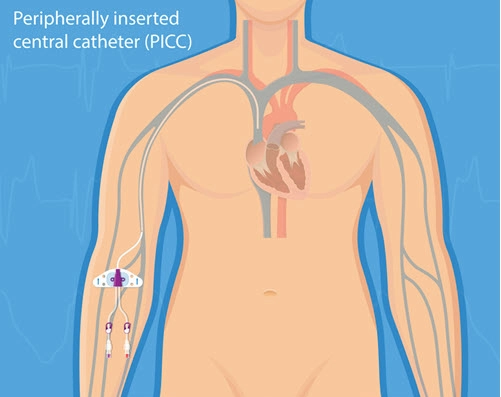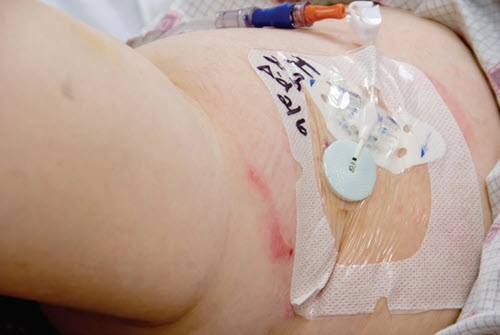General Surgery Coding Alert
‘PICC’ the Best Code for Venous Access
Use this Q/A flowchart to accurately report PICC procedures.
When you face an op report for a peripherally inserted central venous catheter (PICC line), there’s a lot you need to know about the venous system, imaging guidance, and terms like “tunneling.”
In fact, much of that information will determine if you’re dealing with a PICC line at all, or some other venous access procedure.
Terminology: A PICC line is a type of central catheter (long soft tube) that inserts in a peripheral vein in the arm and terminates in a central vein near the heart. You might also find a PICC line referred to as a “percutaneous indwelling central catheter.”
Toolkit: With your surgeon’s report in hand, read the following six questions, find the answers in the op note, and use those answers as a flowchart to narrow down your code choices until you have the correct code.
Question 1: Is the Catheter Tunneled?
If the op note you’re reading mentions that the catheter is “tunneled,” meaning that it is passed under the skin to help keep it in place, you’re not dealing with a PICC line.
“PICCs are not tunneled, so if you see documentation of a ‘tunneled PICC,’ this generally refers to placement of a catheter in a central vein like the internal jugular. For coding purposes, that would be considered a tunneled central venous catheter, according to the Society of Interventional Radiology (SIR),” says Robin Peterson, CPC, CPMA, manager of professional coding, Pinnacle Integrated Coding Solutions, LLC.
If the op report doesn’t mention “tunneled,” move on to question two to narrow your search for the correct PICC code.

Question 2: Where is the Catheter Inserted and Where Does it End?
To qualify as a PICC line, the surgeon must peripherally insert the catheter, which commonly includes locations such as the basilic, cephalic, or saphenous vein.
If the surgeon inserts the catheter in a central vein, such as the jugular, subclavian, or femoral vein, or inferior vena cava, you’re dealing with a centrally inserted central venous access catheter (CVC), not a PICC line.
Termination point: The surgeon should document that the tip of the catheter ends in the superior or inferior vena cava, the right atrium, or the subclavian, brachiocephalic (innominate), or iliac veins. If that’s not the case, you’re not dealing with a PICC line even if it’s peripherally inserted.
For instance: Midline catheters terminate in the peripheral venous system, so you shouldn’t report those with the PICC codes. Instead, code those services as 36400, 36406, or 36410 (… Venipuncture … necessitating the skill of a physician or other qualified health care professional …)
If the veins documented in the op report fit the bill, move on to question three to narrow your search for the correct PICC code.
Question 3: Insert, Repair, Replace, or Remove?
Once you’ve established that your case is a PICC line, you can break down your code search based on which of the following services the surgeon provides:
- Insertion: For placing a PICC line, turn to one of the codes in the range 36568-36571 (Insertion of peripherally inserted central venous …).
- Repair: The repair codes describe services for PICC or CVC lines, and are 36575-36576 (Repair of … central venous access catheter … central or peripheral insertion site).
- Replacement: For replacement of just the catheter, use 36578 (Replacement, catheter only, of central venous access device, with subcutaneous port or pump, central or peripheral insertion site). For complete replacement, use 36584 or 36585 (Replacement, complete, of a peripherally inserted central venous …).
- Removal: Although CPT® provides two codes for removal of central venous access devices (36589 and 36590), you shouldn’t use those codes for a PICC line.
More on removal: The removal code descriptors describe “Removal of tunneled central venous catheter…,” and a text note following the codes states, “Do not report 36589 or 36590 for removal of non-tunneled central venous catheters.” We’ve already established that PICC lines aren’t tunneled, so you shouldn’t use these codes for PICC line removal.
Solution: CPT® doesn’t provide a removal code for PICC lines. “PICC lines are intended to be more short term than a central line, so removal is included as part of a procedure follow-up visit or as part of an E/M service performed on that date,” says Terri Brame Joy, MBA, CPC, COC, CGSC, CPC-I, billing specialty subject matter expert at Kareo in Irvine, CA.
If you’ve gotten to the correct group of codes based on your surgeon’s documentation of insertion, repair, or replacement, move on to question four to further narrow your code choices.

Question 4: Does the Note Document a Pump or Port?
Each group of codes for PICC line insertion, repair, or replacement, breaks down into with or without pump choices, as follows:
- Codes 36568-36573 describe insertions without subcutaneous port or pump, while 36570 and 36571 describe insertions with a subcutaneous port.
- Code 36575 describes repair without a subcutaneous port or pump, while 36576 describes repair procedures that involve a subcutaneous port or pump.
- For complete replacement, code 36584 describes the procedure without a subcutaneous port or pump, while 36585 describes the procedure involving a subcutaneous port or pump.
You should use partial replacement code 36578 only for cases that involve a subcutaneous port or pump, which the code descriptor lists. Report a PICC line catheter-only replacement without a port or pump as part of a procedure follow up or E/M visit.
Bottom line: You should have zeroed in on the correct code for your op report if the PICC line procedure was a repair or replacement. If the procedure was a PICC line insertion, you’ll need to move on to questions five and six.
Questions 5 and 6: What about Image Guidance and Patient Age?
The two groups of codes for PICC insertion without a port or pump are 36568-36569 without imaging guidance, and 36572-36573 with imaging guidance.
The final factor you need to isolate from the op note so that you can pick the correct PICC insertion code is the patient’s age. The codes pair off by age as follows:
Age 5 years or older:
- 36569 — without port or guidance
- 36573 — without port, with guidance
- 36571 — with port
Younger than 5 years of age:
- 36568 — without port or guidance
- 36572 — without port, with guidance
- 36570 — with port
General Surgery Coding Alert
- General Surgery:
‘PICC’ the Best Code for Venous Access
Use this Q/A flowchart to accurately report PICC procedures. When you face an op report [...] - Physician Fee Schedule:
Prepare for Large 2021 Conversion Factor Cut
Expect changes due to COVID-19, too. The Medicare Physician Fee Schedule (MPFS) 2021 proposed rule [...] - ABN:
Update Beneficiary Notification to Protect Your Surgeon’s Bottom Line
Don’t let deadline reprieve fool you. Not getting paid for a surgical procedure because you [...] - You Be the Coder:
Get Details for Cyst Fluid Specimen Case
Question: Our surgeon obtained a sample of fluid from an ovarian cyst under ultrasound guidance [...] - Reader Questions:
File New Claim if ‘Unprocessable’
Question: We received an “unprocessable” claim from our MAC. Can we appeal this? Ohio Subscriber [...] - Reader Questions:
Maintain NPI Across State Lines
Question: Our general surgery practice is moving from Louisiana to Texas. Do our surgeons need [...] - Reader Questions:
Beware Adhesiolysis Bundles
Question: During a splenectomy procedure, the surgeon documents encountering dense adhesions involving the bowel and [...]

